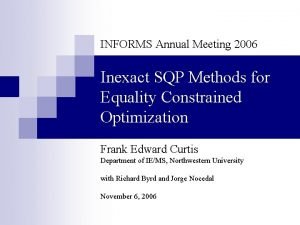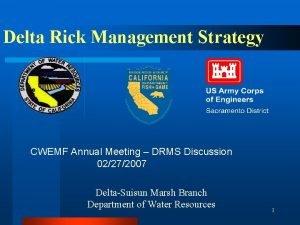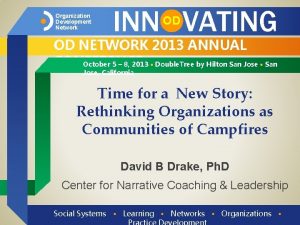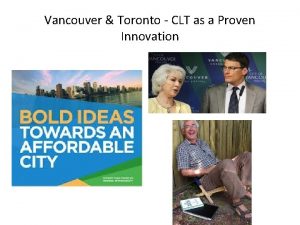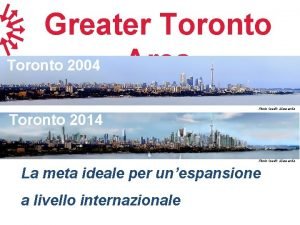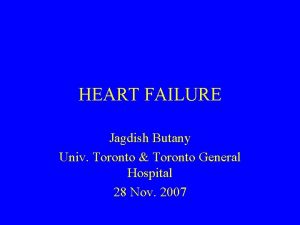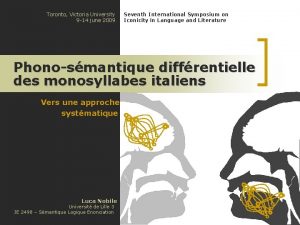Seventh Annual Meeting Innovation Systems Research Network Toronto


















- Slides: 18

Seventh Annual Meeting Innovation Systems Research Network Toronto, 5 -6 May 2005 Clusters, Cluster policies and Innovation Policy Governance: Lessons from EU experience Claire Nauwelaers MERIT, Maastricht University (the Netherlands) 1

Back to the quest for roots of “success” of “places” Ø Generalised awareness of the role of innovation as crucial ingredient for economic development Ø Interactive view of innovation - innovation differs from R&D – role of framework conditions Ø System-based approach to innovation, emphasis on learning and diffusion / absorption of knowledge Ø Mobility of tacit knowledge embedded in humans becomes a key performance factor – « talent » Ø Glocalisation : localised nature of (tacit) knowledge spillovers - importance of global connections 2

Positive relation between regions’ innovation and economic performance www. trendchart. org 3

The Innovation System (encompasses “triple helix”, “four pillars”) Public R&D Innovation policy Intermediaries Training & Education Human capital Venture Capital Incubators, Mentoring… Firms system Large, small, MNCs, NTBFs, … Rules & Regulations Framework conditions MARKETS Business support 4

Policies for innovation systems From “stocks” to “flows” as main focus of policy attention 8 Flows in the system need to be addressed in priority From “raising resources” towards “promoting change” 8 Performance is affected by learning abilities of firms and others From “best practice” towards “context-specific” solutions 8 Policies should be fine-tuned to specific system failures 5

Cluster policies : trials towards systemic innovation policies Ø Cluster concept : variations around core idea of agglomeration and interaction benefits Ø Specific focus on the organisational aspect Ø Most successful forms of clusters : those that open new window of opportunities and cause changes in innovation behaviour – learning Ø Public authorities become part of the system 6

The real nature of Cluster policies = efforts to improve policy interfaces 8 Rather than a new policy area Cluster policies = finding the right mix of instruments 8 Originating from technology, industrial or regional policy toolboxes Clusters as means to reach goals, rather than ends 8 This makes evaluation of success absolutely critical 7

A simple typology of cluster policies Acting on clusters’ environment Facilitating synergies Supporting projects “Heavy” “Light” « Punctual » Clusterinformed policies )all types) Cooperative Researchindustry Platforms Regional / Local Initiatives Clusters identity building Cooperative projects of SMEs Networks Collaborative R&D projects 8

Main characteristics of cluster policies in the EU ü ü ü ü ü Most countries are engaged in some sort of cluster policy Explicit or implicit policies Originate from technology, industrial or regional policies (path dependency) Different targets Variety in portfolio of instruments, borrowed from parent policy areas, tailor - made mix From top-down to bottom-up Different levels of intervention Various entry points in an idealised sequence for policy design : mapping – selection – initiation – growth support – exit European dimension : in infancy Variety in cluster policy models 9

The versatility of the Cluster concept Mega-Clusters Local Networks Knowledge-based 10

Mega clusters Local Networks Knowledge based Industry Competitiveness Territory Competitiveness Innovation, Technological Development Sectors, « filières » , market, value-chain SMEs (large enterprise) Entreprises and research centres Micro Meso Enterprise dynamics Knowledge flows Macro Meso Mapping studies, empirical analyses 11

Mega clusters Local Networks Knowledge based Critical mass, presence Geographic proximity, Regulatory and of complete “filières”, entrepreneurship, social institutional framework, factor conditions, capital, communication, efficient intermediaries, demand, adapted labour vision, leadership, co- match in specialisations, market, …. opetition, competence venture capital , base, … knowledge flows… Finnish clusters, Scottish clusters, Austrian clusters, Basque country clusters, Danish “resource areas” , Dutch “mega-clusters”, … Italian industrial districts, French SPL, Greek clusters, Danish networks of competence, Norway SME development policy, Welsh supplychains…, Dutch R&D partnerships, Flemish “VIS”, Walloon and Luxembourg technology clusters German Bioregions, Finnish centres of expertise, competence centres (SEAU…)…, 12

Notion of Cluster « success » vary Mega-Clusters : « Competitiveness » Local Networks : « Thickness » Knowledge-based : « Innovation » 13

State-of-the art in cluster evaluation Cluster evaluation : in infancy. Interest in cluster « per se » 8 Cluster benefits often taken for granted rather than analysed Cluster policy evaluation : need to question additionality 8 Finland has not developed an ICT cluster policy… Ex-ante assessment more developed than ex-post evaluation 8 Empirical techniques seldom used in policy evaluation High focus on localized linkages demonstration 8 Often disappointing: clusters = local nodes in global networks Neglect of competition as a main driving force 8 Major focus on cooperative and supply-chain 14

Future of cluster policies Understand position of clusters in their life-cycle 8 From emergence to growth to maturity and decline Focus on innovative combinations of activities (cluster v. sector) 8 Empirical methods (e. g. location quotient) useful but not sufficient Analyze untraded interdependencies (innovation, social capital, talent…) 8 Analyzes based on input-output tables fail to measure this Define functional regions (cfr. German networks of excellence) 8 From firm dynamics rather than political boundaries Examine external and internal connections (Italian Industrial districts) 8 A combination of both is necessary for clusters’ success 15

Key challenges for cluster evaluation Ø Concentrate evaluations on clustering processes and trajectory rather than on static measures ü FDI, firms displacement and creation, . . . ü People mobility, employment growth ü Role of key actors or events Ø Focus evaluations on immaterial flows rather than material flows ü Innovations, technology licensing, patents citations, . . . (realm of innovation policy) ü Managerial skills, entrepreneurial skills, … (realm of human resource policy) 16

Regional Innovation Policy : The way forward l Government’s role shifts from investor to facilitator - promotion of public/private partnerships and interface management l Improving knowledge governance in firms and clusters of firms becomes a key issue for policy l Policies need to "open borders" : between : traditional fields of policy intervention ï industries traditionally defined ï various forms of knowledge production and diffusion ï 17

Regional Innovation Policy : The way forward Danger of fragmentation of innovation policy : need for intra-government policy coordination l Increasing role of regions for innovation : need for vertical policy coordination l More efficiency through “Policy packages” rather than isolated instruments l Need for more policy intelligence l – – – monitoring and evaluation of policies sound analyses of innovation systems « intelligent » benchmarking practices – no « best practices » ! long term views inclusive policy design processes 18
 Mysite.socccd
Mysite.socccd Radical vs disruptive innovation
Radical vs disruptive innovation Principles of information systems
Principles of information systems Toronto shelter network
Toronto shelter network Informs annual meeting
Informs annual meeting Aupha annual meeting
Aupha annual meeting American psychiatric association annual meeting 2020
American psychiatric association annual meeting 2020 Masonic lodges in kentucky
Masonic lodges in kentucky Positron vs proton
Positron vs proton Cwemf
Cwemf How to run an annual general meeting
How to run an annual general meeting Nrg oncology meeting 2018
Nrg oncology meeting 2018 Aashto annual meeting 2015
Aashto annual meeting 2015 Scts annual meeting
Scts annual meeting Nrg oncology semiannual meeting
Nrg oncology semiannual meeting American epilepsy society annual meeting 2017
American epilepsy society annual meeting 2017 Network systems design using network processors
Network systems design using network processors Hcsrn
Hcsrn What is vating
What is vating




